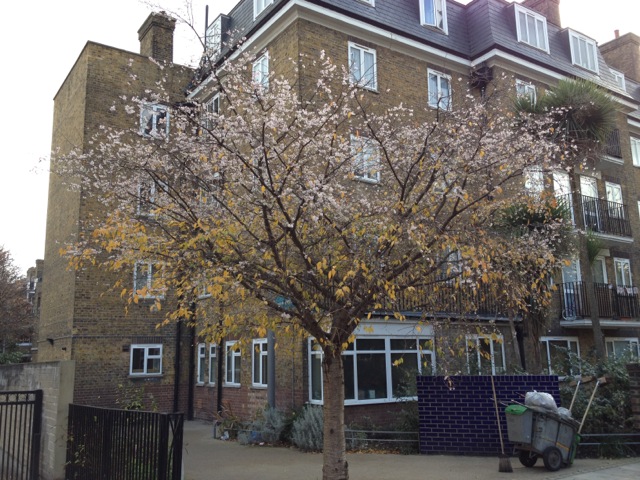My Guardian colleague Juliet Jowitt wrote the other day about nature being fooled into a ‘second spring’ by the warm autumn. This morning I saw an almost spooky manifestation of that phenomenon: an ornamental cherry tree in east London in full blossom, still with its turning autumn leaves. Something rather apocalyptic about it.
Update, 28 November: People who know more about ornamental trees than me have pointed out on Facebook that this may just be a winter-flowering cherry tree. I’m embarrassed to admit that I didn’t know such things existed. Nonetheless, I’ve fairly sure I’ve never seen any cherry tree with quite that combination of turning leaves and full blossom. In fact, I first noticed it because quite a few people on the street were pointing to it and discussing it.
Anyway, apologies if this is in fact nothing unusual. Can anyone confirm? Either way, in my defence, note that scientists are observing very strange things this November, including spring blossoms. A few extracts from Juliette’s report the other day:
This year earlier-than-ever autumn colours and fruits have been mixed with prolonged signs of summer wildlife such as dragonflies, butterflies and grass snakes, and spring flowers such as magnolia, apple blossom and honeysuckle blooming – making it a truly extraordinary season …
The Centre for Ecology and Hydrology reported that some spring species recorded their earliest appearance since records began in the late 1700s – and a poor summer and drought in parts of the country are all thought to have played a part …
There is some debate among experts, however, about whether they are witnessing a second spring or if next year’s has come early. “I think what’s happened is that that very warm, late spell in October has really fooled a few things into thinking spring’s turned up early again – forgetting the fact they haven’t had a winter,” said Bullock [of the Wildfowl and Wetlands Trust] …
A paper led by the Centre for Ecology and Hydrology, published in 2010, analysed 25,000 trends for 726 species and calculated that on average seasonal events were occurring 11 days earlier than a generation ago.
